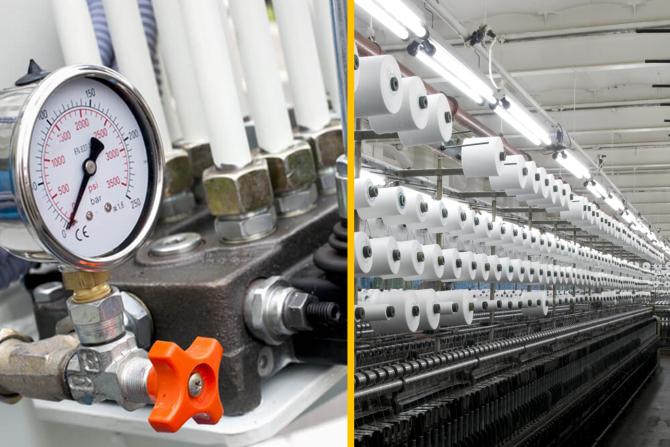It is known to all that moisture is always present…

Importance of Compressed Air in the Textile Industry
Compressed air is considered as one of the significant utility services to carry out industrial operations. When the volume of normal air is decreased with a compressor, then it is called compressed air. Along with electricity, water and steam; Compressed air is one of the major necessities that is used extensively at every stage of operations in the textile industry. This is available comparatively at a lower investment and maintenance rate than the energy it consumes. Choosing the right compressor system helps in both natural and man-made textile production.
Oil-free compressors with newer technology decrease waste and optimise production level reducing idle time. Managing logistics becomes easier, along with that the products can be supplied on time due to uninterrupted production. The system proves to be highly beneficial for the manufacturers.
Uses of Compressed Air:
Basically, compressed air is necessary to power air blow guns, nozzles along with in air knives for activities including movement, lifting, or cooling different items. A large volume of compressed air is required regularly for comprehensive textile production units.
In this industry, it is highly important to power spinning machines, grinning mills and other machineries for processing Denim, yarn production and more. Its significance is higher in industries that operate with Airjet looms and produce polyester yarns as well. It helps to add texture to various fabrics increasing the value of finished goods.
Apart from these areas, it is needed for winding and dying of nonwoven materials too. Air compressors help in powering additional tools which are used for cleaning facilities and for ensuring optimum efficiency of the entire unit. Without compressed air, treatment of waste water cannot be performed.
The Advantages
Compressed air helps textile manufacturers to overcome various problems associated with fabric and yarn production. The most important-factor among these is cost effectiveness. This happens because it ensures fast and effective production adding competitive value to the company itself.
Compressed air also helps in sustaining its tools and other support equipment. It allows manufacturers to increase productivity rate and lower time consumption as at the highest efficiency as possible.
Using compressed air and with the help of sustainable solutions, the textile industry aims to minimise or manage waste production as well.
The Disadvantages
When volume of normal air is compressed, air pressure increases and as a by-product heat is generated out of this reaction. This heat helps to keep powering the manufacturing units. The entire procedure depends on seamless supply of high voltage electricity. That is why; it is regarded as one of the most energy consumable utilities used in the industrial sector. Although the entire system is highly expensive for the manufacturers, it ensures uninterrupted flow of effective production mostly.
Regular maintenance is very important for such systems. However, if we do not check for certain factors; like dust and dirt build up, humidity or temperature of the air, those can harm its efficiency over time affecting the flow of production too.
Factors that affect compressor’s efficiency
When compressed air has dirt and gunk, it must be a result of dust and dirt build up inside the compressed air unit. If not regularly maintained, it can damage a compressor and it might lose its lifetime and efficiency over time.
Air that holds a higher amount of water vapour, consumes higher energy while being compressed. The chance is water might accumulate inside the system causing rust and damage to its structure.
Cold air is easy to compress as it is in a more compressed state than hot air. Hence, time and energy can be saved if cold air is used instead of hot air inside the system.
Compressed Air – The Big Boon for Textile Industries
It can be said that textile manufacturers literally depend on the compressed air system. Clearly, profit margin of the business is associated with this both directly and indirectly. If a compressed air system runs on its optimum efficiency; production becomes seamless, business increases and deliverables never run behind the schedule.




